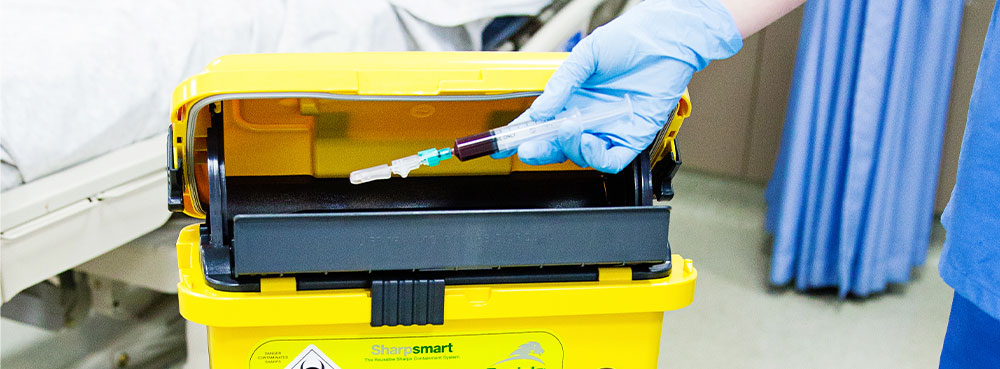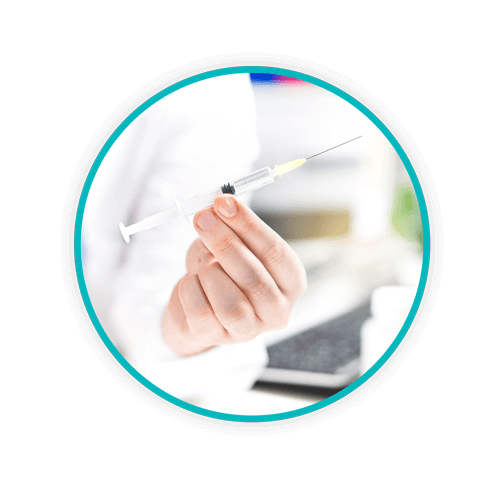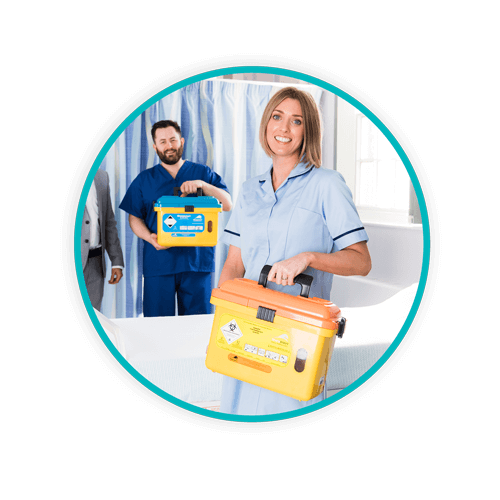How to Dispose of Sharps Waste

What exactly is sharps waste? The name is key. In healthcare scenarios, sharps waste is typically defined as a needle, but in reality, it is anything that has a capability of poking, cutting, slashing, or otherwise injuring the skin, with the potential to expose the injured person to a contaminant or bloodborne pathogen. Compliant processes and disposal practices of sharps waste can aid in the reduction of risks associated with contamination or infection of bloodborne pathogens that include, but are not limited to hepatitis B, hepatitis C, HIV, and AIDS.
According to the Royal College of Nursing, there has been a disturbing rise in needlestick injuries in recent years. Lack of training, unavailable sharps bins, fatigue, and low staffing were cited in their report as the reasons for the increase. In order to begin to address these challenges, it’s important to understand how to properly dispose of sharps waste.
TOPICS WE WILL COVER
1 / Identifying and dealing with sharps waste
3 / Education and training are key
4 / Tips for smart sharps disposal
5 / Sharpsmart takes a clinical approach to sharps disposal practices
Identifying and dealing with sharps waste
Throughout the UK, sharps are also known as a type of clinical waste. Clinical waste is considered any type of waste that can cause infection or disease. Clinical waste is produced by healthcare service providers in a broad range of services, such as outpatient clinics or centres, dental practices, hospitals, veterinary services, pharmaceutical dispensaries, and research and development labs.
As such, clinical waste includes a number of contaminants that can be found on a sharp, such as:
- Blood and/or body fluids
- Chemicals such as cytotoxic medicines and/or other drugs
It is your duty of care to properly identify, assess, and classify all your waste streams, including sharps and other clinical wastes. Turn to government resources for instructions to ensure compliance.
Who makes sharps rules?
Knowing the rules is the first step toward compliant sharps disposal. For starters, the International Organization for Standardisation document supplies guidance that protects healthcare providers against sharps injuries. Sharpsmart containers are the only reusable containers in the UK certified to ISO standards. When it comes to disposal, they recommend sharps containers that are:
- Resistant to puncture
- Are a highly visible colour for medicinal products (such as yellow)
- Spill and leakproof
A sharps container or bin is not just for needles, but can also include syringes, clippers, and lancets or “finger poke” devices used by diabetics. Whether in a home-based scenario or healthcare facility, sharps bins must be located in safe areas and preferably at shoulder height so as to reduce the risk of children reaching them.
Guidance can also be found within the Health and Safety Regulations of 2013 (Sharp Instruments in Healthcare). This document specifies legal obligations as well as responsibilities when it comes to the proper and safest use of sharps containers. They include sharps disposal guidance as well as when and how to report a sharps injury.
Another aspect of sharps disposal is to assess current risk control measures in place at any facility. Control measures to protect against sharps injuries include avoiding unnecessary use of sharps and education regarding safer sharps usage, such as not attempting to recap needles after use. Placement of sharps containers is key. Such bins or containers should be secure and easily accessible for disposal.
Be aware that now that the UK has separated from the EU, some procedures have changed and are undergoing updates regarding processes. It is the responsibility of healthcare waste generators to be aware of such changes that affect health and safety in healthcare environments. Turn to authorities such as the National Health Service and its representatives as needed.
Education and Training Are Key
Sharps regulations can be found in a variety of government guidelines and documents, including those of the Control of Substances Hazardous to Health Regulations (COSHH). However, it is the duty of care of healthcare employers and facilities to also routinely assess risk control measures on an ongoing basis.
Correct traceability of sharps containers is also important, and documentation regarding transportation of such containers is often required.
Healthcare networks in regions throughout the UK may also stipulate their own guidelines in addition to those of the government. Rules can be quite specific, such as the date of locking a sharps bin or wheelie, the name of the person locking that bin, and assurance that any sharps bins waiting for pickup and disposal are stored securely in locked areas.
Guidelines are also available for sharps disposal practices by patients in their own homes as well as travelling nurses or other healthcare staff who travel within the community and carry used or unused sharps during the course of their work.
Tips for smart sharps disposal
Following regulations for sharps disposal can ensure safety for those handling such objects. A few tips for smart sharps disposal can also prove effective in reducing the risk of needlestick injuries, exposure to bloodborne pathogens, and unacceptable access to such items by the public or wildlife rummaging around waste storage areas.
- Immediately after use, place needles or other sharps into a compliant sharps disposal container. The closer that container is to the point of care, the better.
- Never bend, attempt to break, or recap a needle before disposal into an appropriate sharps disposal container.
- Sharps containers must be clearly marked as such, with the appropriate label and biohazard symbols that clearly define its contents.
Refer to UK government guidelines as well as local or community regulations regarding destruction of sharps, such as on-site or off-site incineration, or autoclaving. For example, the University of Birmingham requires that sharps waste be treated before its final disposal, especially clinical waste that contains or has been contaminated with tissues, microbiological remnants, or cultures, and so forth.
Sharpsmart takes a clinical approach to sharps disposal practices
Reusable sharps containers are a reliable and cost-effective solution for healthcare facilities and healthcare providers in a wide range of healthcare scenarios. We know that ever-changing regulations can be not only complex, but confusing. Safety is key. Reducing the potential of needlestick injuries and promoting the use of reusable sharps containers not only reduces greenhouse gases and emissions, but is a long-term solution for safe sharps disposal. For more information about resources, waste reduction, and solutions when it comes to healthcare waste, contact Sharpsmart today.
Let's Talk!
Your time is valuable, and we don’t want to play hard to get. You can either phone us directly on the details listed on our contact page, or feel free to fill out this short form and one of our team members will get back to you as quickly as possible.
